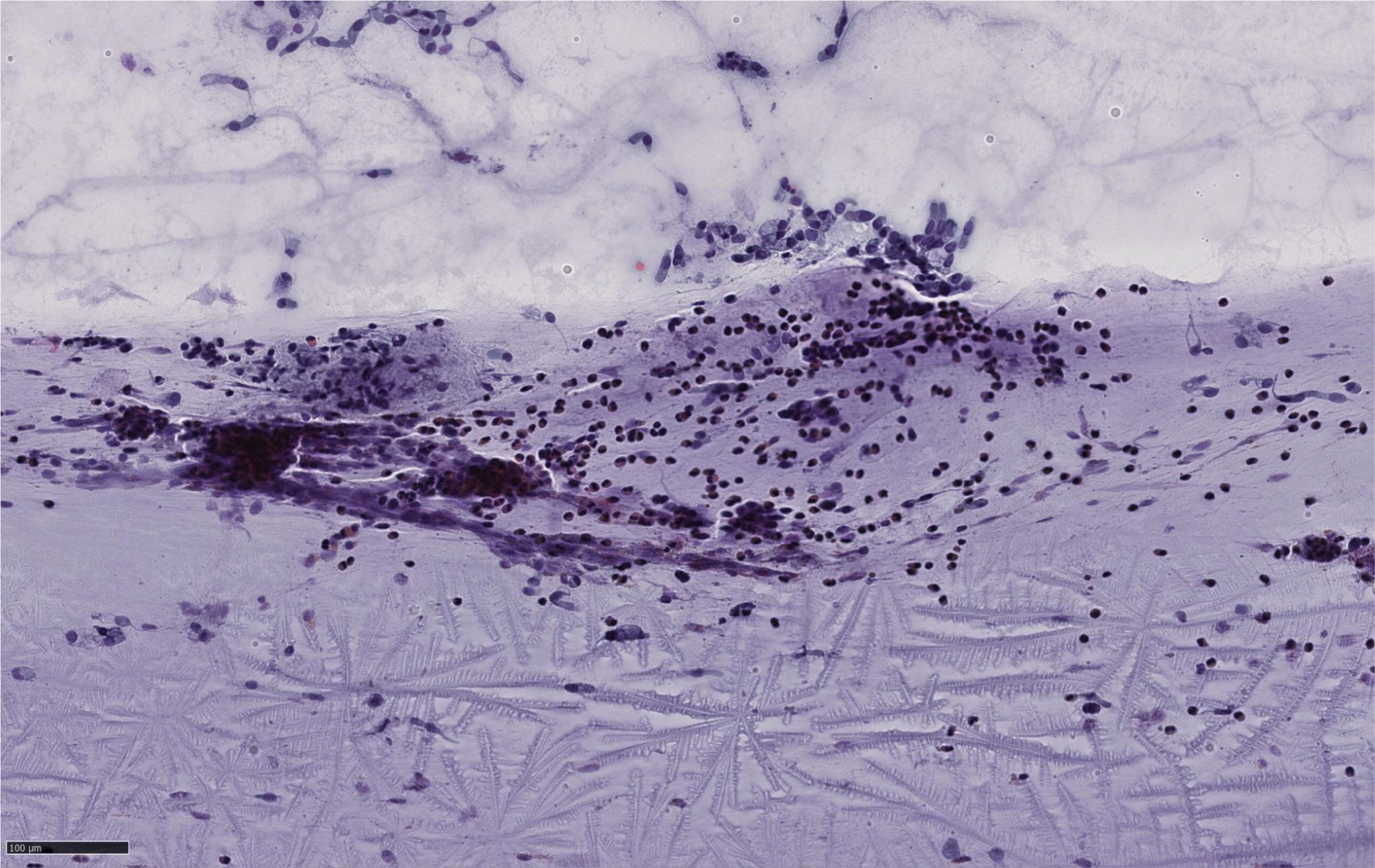1.
Introduction
Non-allergic rhinitis with eosinophilia syndrome (NARES) is a chronic inflammatory rhinopathy non-IgE-mediated. It is a subtle disease characterized by nasal obstruction, rhinorrhea, sneezing and/or itchy nose [1]–[3].
Even though the typical patient has a significant number of eosinophils in the nasal cytology compared to those with allergic rhinitis, detection of these cases remains challenging due to the lack of consensus on the role of nasal cytology in clinical practice [4].
It is quite common for these individuals undergo several allergy tests with results that may be either completely negative or positive, but without a clear clinical correlation [2]. These patients are eventually diagnosed with idiopathic/aspecific rhinitis [2]. Subsequently, the allergist may recommend a topical treatment regimen that includes intranasal corticosteroids, intranasal antihistamines or a combination of both types of medication [3].
Thanks to nasal cytology, it is possible to identify and more accurately classify non-allergic rhinopathies [4]. NARES is characterized by a significant nasal eosinophilia, up to 50–70% of the total cells present in the mucosa, not associated with allergic disease [4],[5]. Furthermore, in severe cases this condition may be accompanied by non-IgE-mediated asthma, aspirin intolerance and nasal polyps [6],[7]. Another entity is NARMA (non-allergic rhinitis with mast cells), which is characterized by a predominant infiltration of mast cells (>10% of total nasal cells) [8],[9]. On the other hand, NARNE (non-allergic rhinitis with neutrophils) is characterized by a predominant neutrophilic inflammation (>50% of total nasal cells) without concurrent bacterial colonization [4]. Additionally, there exists a type of NAR characterized by simultaneous infiltration of eosinophils and mast cells known as NARESMA (non-allergic rhinitis with eosinophilia and mast cells) [9].
2.
Case description
In the present report, we describe the case of a 24-year-old female patient, non-smoker, not exposed to professional irritants, who had been recently diagnosed with NARES through nasal cytology.
She was brought to our attention as she presented a severe grade oculorhinitis that had been poorly controlled for five years and was characterized by persistent nasal obstruction and conjunctivitis. Pharyngitis and sporadic exertional dyspnea were also reported.
Beforehand, she had undergone skin testing for aeroallergens and allergen-specific IgE testing in blood but no positive findings were detected. Initially, she used antihistamines and corticosteroid nasal spray to alleviate her symptoms with satisfactory results. However, over time the effectiveness of this treatment gradually declined.
She underwent a first Ear-Nose-Throat (ENT) visit, where the specialist observed a pinkish, pale nasal mucosa with hypertrophy of the nasal turbinate as well as an inflamed and red oropharyngeal mucosa.
Global spirometry, bronchodilation test, exhaled Nitric Oxide detection and ergospirometry were negative.
Because of the intensity and persistence of symptoms, a second ENT visit was conducted. The specialist reported a nasal hyperreactivity with pale nasal mucosa and a small blood lesion on the left nasal fossa's mucosa due to mechanical trauma of prolonged use of nasal corticosteroid spray. During this instance, a nasal scraping cytology was conducted on the surface of the middle section of the inferior turbinate providing a characterization indicative of eosinophilic non-allergic rhinitis (Figure 1).
She was prescribed a nasal spray based on azelastine hydrochloride and fluticasone propionate, to be done in 15-day cycles and antihistamine therapy as needed with the patient's subjective transient benefit.
We also prescribed a blood count with leukocyte formula which revealed 0.26 × 109 U/L eosinophils.
Given the absence of stable benefit for the patient with conventional therapies and the presence of marked eosinophilic inflammation, mepolizumab was proposed as a Day Hospital treatment. The off-label use of the drug was performed with informed consent obtained in accordance with our hospital's policy for off-label drug administration. Mepolizumab (circulating IL-5 mAb), a drug approved for the treatment of severe asthma with hypereosinophilia, obtaining the patient's consent, was administered once a month at the dose of 100 mg subcutaneous due to the ineffectiveness of systemic and topical therapy and the patient's low quality of life (QOL).
The drug had already been described as a potential therapeutic alternative in patients with NARES [1].
After the first administration of mepolizumab, the patient reported a subjective improvement of symptoms Therefore, nasal spray therapy based on azelastine hydrochloride and fluticasone propionate was reduced. After the fifth injection, the patient reported only a sporadic use of the topical therapy.
As the symptoms had regressed, it was decided to discontinue mepolizumab treatment after a dialogue with the patient. However, symptoms recurred two months later. Treatment was then resumed. The patient achieved complete symptom remission one year after initiating off-label treatment with mepolizumab 100 mg subcutaneously. Blood tests including a complete blood cell count, hepatic and renal profiles were performed on the patient throughout the therapeutic process. Special attention was given to monitoring the eosinophilic population in the peripheral blood which remained stable over time. In the most recent eosinophilic control the count was 0.2 × 109 cells/L.
In the ENT follow-up conducted after 13 months of treatment, the specialist reported normal nasal mucosa and normal sized turbinates, absence of secretions and neoformations. Moreover, cryptic intravelic tonsils on horoscopy. Nasal cytology performed during this evaluation revealed presence of rare neutrophils and small lymphocytes and absence of eosinophils, microorganisms and malignant tumor cells (Figures 2 and 3).
3.
Discussion and conclusions
Mepolizumab is a humanized monoclonal antibody belonging to the IgG1/k class whose target is IL-5 commercialized in Italy in 2017. IL-5 is a key cytokine, part of the type 2 infection, involved in the pathogenetic mechanism of severe asthma and it is critical in promoting eosinophil generation, recruitment, activation and survival [10]. In addition, mepolizumab is currently indicated as an add-on therapy for: hypereosinophilic syndrome (HES) in adult patients with inadequately controlled HES without an identifiable non-hematologic secondary cause; severe chronic rhinosinusitis with nasal polyposis (CRSwNP) in patients for whom systemic corticosteroid therapy and/or surgery fail to provide adequate disease control; relapsing/remitting or refractory eosinophilic granulomatosis with polyangiitis (EGPA). Major basic protein, eosinophilic cationic protein, eosinophilic-derived neurotoxin and eosinophil peroxidase are the four main proteins secreted by activated eosinophils. They also release inflammatory mediators such as cysteinyl leukotrienes, platelet-activating factor and prostaglandin D2. Together, these eosinophil-derived substances cause the recruitment and activation of inflammatory cells which in turn contributes to the remodeling and hyperresponsiveness of the airways that underlie asthma attacks. By interfering with cytokine binding to the alpha chain of the receptor complex on the cell surface, particularly by eosinophils, mepolizumab is able to limit the bioactivity of IL-5. This suppresses the signal of IL-5, causing a reduction in eosinophil production and recovery [9].
Most of the existing literature strongly recommends the implementation of a standardized approach for nasal cytology which involves depositing the sample onto a glass slide, allowing it to air-dry and subsequently applying the May-Grünwald-Giemsa (MGG) stain. Following the staining process, the slides are meticulously examined using optical microscopy equipped with a 1000× objective lens and employing oil immersion [4].
One of the inherent limitations of this case report stems from the utilization of a non-standardized technique during the nasal cytology procedure by the ENT and pathology specialists. Nonetheless, these experts emphasize that employing the Cytofix and PAP staining method ensures precise visualization of cellular components. Especially if in addition to the inflammatory cells, there is a desire to simultaneously study the cellular nucleus to exclude cancerous atypia.
The authors reiterate in their conclusion the significance of suggesting nasal cytology when there are rhinitis symptoms present with a negative skin prick test or allergen-specific IgE in the blood, in suspicion of NARES.
In addition to improving the subject's quality of life treating this condition is crucial since those who have NARES run a higher chance of developing nasal polyposis [11]. NARES can occasionally be the first sign of Widal syndrome [11].
This case of a 24-year-old female who presented severe NARES and resistance to topical therapy, supports the findings of improvement in clinical outcomes and QOL after received treatment with Mepolizumab. Our review of the scientific literature suggests that this is the first reported case.
Further studies need to be conducted to validate these findings.










 DownLoad:
DownLoad:





